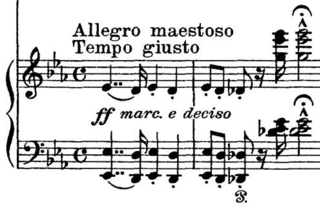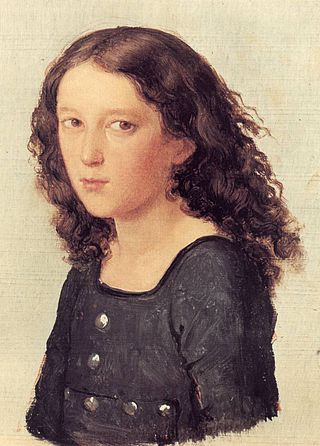External links
- Hungarian Rhapsody No. 10 : Scores at the International Music Score Library Project
Hungarian Rhapsody No. 10 in E major , S.244/10, is a composition for solo piano by Franz Liszt. It is tenth in the set of his Hungarian Rhapsodies, and is subtitled Preludio, although this name is not commonly used. It, along with the rest of the first fifteen rhapsodies, were published in 1853.
After a brief introduction with three glissando-like passages in a rather free time, the tempo changes to Andante deciso, and the first theme is introduced. After a cadenza, the tempo changes to Allegretto capriccioso and a much darker theme is introduced, this time in the parallel minor of E minor. Despite the fact that it is a much darker theme, the carefree feel of the piece remains. After some time, there is a fairly long cadenza filled with trills between the hands, as the key modulates freely. The glissando-like passages return to be a repeated theme for the rest of the piece, especially when the tempo changes to a much faster Vivace and the key changes to C major. This results in many glissandos, sometimes in both hands. After this, the darker second theme returns in E minor, this time sempre forte brioso, meaning always loud and spirited. Before the end of the piece, the key changes back to E major, the original key, and a new theme is introduced. The piece ends in loud, booming chords in both hands. A typical performance time is around 5 minutes.
The piece is one of the more popular Hungarian Rhapsodies.
The entire rhapsody is based on Béni Egressy's Fogadj Isten, which was published in May 1846 in honor of Liszt.

Rhapsody in Blue is a 1924 musical composition written by George Gershwin for solo piano and jazz band, which combines elements of classical music with jazz-influenced effects. Commissioned by bandleader Paul Whiteman, the work premiered in a concert titled "An Experiment in Modern Music" on February 12, 1924, in Aeolian Hall, New York City. Whiteman's band performed the rhapsody with Gershwin playing the piano. Whiteman's arranger Ferde Grofé orchestrated the rhapsody several times including the 1924 original scoring, the 1926 pit orchestra scoring, and the 1942 symphonic scoring.

The Rhapsody on a Theme of Paganini, Op. 43, is a concertante work written by Sergei Rachmaninoff for piano and orchestra, closely resembling a piano concerto, all in a single movement. Rachmaninoff wrote the work at his summer home, the Villa Senar in Switzerland, according to the score, from 3 July to 18 August 1934. Rachmaninoff himself, a noted performer of his own works, played the piano part at the piece's premiere on 7 November 1934, at the Lyric Opera House in Baltimore, Maryland, with the Philadelphia Orchestra conducted by Leopold Stokowski.
A variety of musical terms are likely to be encountered in printed scores, music reviews, and program notes. Most of the terms are Italian, in accordance with the Italian origins of many European musical conventions. Sometimes, the special musical meanings of these phrases differ from the original or current Italian meanings. Most of the other terms are taken from French and German, indicated by Fr. and Ger., respectively.

Sergei Rachmaninoff's Piano Concerto No. 3 in D minor, Op. 30, was composed in the summer of 1909. The piece was premiered on November 28 of that year in New York City with the composer as soloist, accompanied by the New York Symphony Society under Walter Damrosch. The work has the reputation of being one of the most technically challenging piano concertos in the standard classical piano repertoire.

The Piano Concerto No. 3 in C minor, Op. 37 is generally thought to have been composed in 1800, although the year of its composition has been questioned by some contemporary musicologists. It was first performed on 5 April 1803, with the composer as soloist. During that same performance, the Second Symphony and the oratorio Christ on the Mount of Olives were also premiered. The composition was published in 1804, and was dedicated to Prince Louis Ferdinand of Prussia. The first primary theme is reminiscent of that of Mozart's 24th Piano Concerto.

Felix Mendelssohn's Violin Concerto in E minor, Op. 64, is his last concerto. Well received at its premiere, it has remained among the most prominent and highly-regarded violin concertos. It holds a central place in the violin repertoire and has developed a reputation as an essential concerto for all aspiring concert violinists to master, and usually one of the first Romantic era concertos they learn. A typical performance lasts just under half an hour.
Three Concert Études, S.144, is a set of three piano études by Franz Liszt, composed between 1845–49 and published in Paris as Trois caprices poétiques with the three individual titles as they are known today.

Franz Liszt composed his Piano Concerto No. 1 in E♭ major, S.124 over a 26-year period; the main themes date from 1830, while the final version is dated 1849. The concerto consists of four movements and lasts approximately 20 minutes. It premiered in Weimar on February 17, 1855, with Liszt at the piano and Hector Berlioz conducting.
A Symphony to Dante's Divine Comedy, S.109, or simply the "Dante Symphony", is a choral symphony composed by Franz Liszt. Written in the high romantic style, it is based on Dante Alighieri's journey through Hell and Purgatory, as depicted in The Divine Comedy. It was premiered in Dresden in November 1857, with Liszt conducting himself, and was unofficially dedicated to the composer's friend and future son-in-law Richard Wagner. The entire symphony takes approximately 50 minutes to perform. It premiered on 7 November 1857.

Hungarian Rhapsody No. 2 in C-sharp minor, S.244/2, is the second in a set of 19 Hungarian Rhapsodies by composer Franz Liszt, and is by far the most famous of the set.
An octave glissando is a glissando played on the piano by maintaining a constant distance of an octave between the thumb and finger used to execute it, and shifting the whole hand in the direction of the glissando.

Grande sonate: Les quatre âges is a four movement sonata for piano by Charles-Valentin Alkan. The sonata's title refers to the subtitles given to each movement, portraying a man at the ages of 20, 30, 40, and 50. The work was published in 1847, dedicated to the composer's father, Alkan Morhange.
Hungarian Rhapsody No. 6 in D-flat major is the sixth work of the 19 Hungarian Rhapsodies composed by Franz Liszt. This work was dedicated to Count Antoine of Appony and uses the form of lassan and friska like many other of his rhapsodies. This piece was later arranged for orchestra.
The Fantasia on Hungarian Folk Melodies, commonly known in short form simply as the Hungarian Fantasy, is Franz Liszt's arrangement for piano and orchestra of his Hungarian Rhapsody No. 14, originally for solo piano. The Fantasia was written in 1852 and premiered in Pest on June 1, 1853, with Hans von Bülow as soloist and Ferenc Erkel conducting the orchestra.

Hungarian Rhapsody No. 19 (S.244/19) in D minor is the last of a set of 19 Hungarian Rhapsodies by the Hungarian composer Franz Liszt. It was written in 1885.
The Variations on a Rococo Theme, Op. 33, for cello and orchestra was the closest Pyotr Ilyich Tchaikovsky ever came to writing a full concerto for cello and orchestra. The style was inspired by Mozart, Tchaikovsky's role model, and makes it clear that Tchaikovsky admired the Classical style very much. However, the Theme is not Rococo in origin, but actually an original theme in the Rococo style.
Hungarian Rhapsody No. 9, S.244/9, in E-flat major, is the ninth Hungarian Rhapsody by Franz Liszt. It is nicknamed the "Carnival in Pest" or "Pesther Carneval" and was composed in 1847. A typical performance of the piece lasts ten minutes.
Hungarian Rhapsody No. 15, subtitled Rákóczi March, S.244/15, in A minor, is the fifteenth Hungarian Rhapsody by Franz Liszt. Written in 1853, the rhapsody is based on the Rákóczi March. An average performance of the piece lasts around six minutes.
Hungarian Rhapsody No. 16, S.244/16, in A minor is the sixteenth Hungarian Rhapsody composed by Franz Liszt for solo piano. It was composed and published in 1882. The rhapsody, subtitled Budapest Munkácsy-Festlichkeiten, has a duration of approximately five minutes and is dedicated to Mihály Munkácsy. It was arranged for piano four-hands by the composer himself, marked as S.622, published in the same year. The piece begins with an outset of the main theme, A Minor, but with a distinct ambiguity of tonality. This section ends with a cadenza. The following section introduces a new theme, marked Lassan Langsam, and also ends with a cadenza. The third section is a repeat of the second section, but transposed to B-flat Minor. The fourth section of the piece repeats the theme from the first section and segues to the Friska of the piece, marked Allegro con Brio. This introduces the parallel major to A Minor as the tonic and continues with lively variations on the first theme. The piece concludes with octaves ascending the keyboard in A Major arpeggios and is finished on four final A Major chords.

The Concerto for Piano, Violin, and Strings in D minor, MWV O4, also known as the Double Concerto in D minor, was written in 1823 by Felix Mendelssohn when he was 14 years old. This piece is Mendelssohn's fourth work for a solo instrument with orchestral accompaniment, preceded by a Largo and Allegro in D minor for Piano and Strings MWV O1, the Piano Concerto in A Minor MWV O2, and the Violin Concerto in D minor MWV O3. Mendelssohn composed the work to be performed for a private concert on May 25, 1823 at the Mendelssohn home in Berlin with his violin teacher and friend, Eduard Rietz. Following this private performance, Mendelssohn revised the scoring, adding winds and timpani and is possibly the first work in which Mendelssohn used winds and timpani in a large work. A public performance was given on July 3, 1823 at the Berlin Schauspielhaus. Like the A minor piano concerto (1822), it remained unpublished during Mendelssohn's lifetime and it wasn't until 1999 when a critical edition of the piece was available.